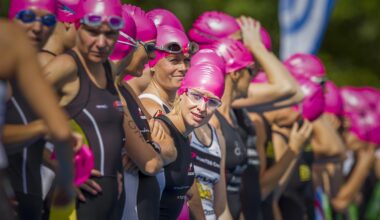Incorporating Olympic Lifts for Explosive Strength Development
Explosive strength is crucial for sprinters, providing them the power needed for optimal performance. Olympic lifts, such as the clean and jerk, and the snatch can significantly boost an athlete’s explosive strength. These lifts focus on dynamic movement patterns that engage multiple muscle groups simultaneously, refining overall coordination and efficiency. Additionally, this type of training improves the athlete’s ability to generate force quickly, which is essential for sprint starts and explosive acceleration down the track. By incorporating these lifts into a training regime, sprinters can not only increase their power but also enhance their muscular endurance. It’s important to note that Olympic lifting requires proper technique to prevent injuries, so utilizing a qualified coach for instruction and feedback is essential. Athletes should begin by mastering basic lifts before progressing to more complex movements. Consistent practice with the right focus on form will cultivate explosive abilities that can be tailored towards competition readiness. With dedication and the right systematic approach, Olympic lifts can transform a sprinter’s capability, helping them to achieve personal bests every season.
Benefits of Olympic Lifts for Sprinters
In our training journey, understanding the benefits of Olympic lifts is paramount. Elite sprinters can leverage these lifts to enhance various physical attributes essential for sprinting success. First, Olympic lifts improve strength, particularly in the posterior chain—muscles crucial for sprinting speed. These exercises activate the glutes, hamstrings, and calves, leading to improved stride length and frequency. Additionally, they develop explosive power; this quick release of energy enables rapid acceleration. Enhancing force production allows sprinters to push off harder from the starting blocks, leading to faster race times. Moreover, Olympic lifts teach athletes how to absorb force effectively, promoting resilience against injuries during intense training. The lifts also incorporate core strength, which stabilizes the athlete during sprinting and contributes to maintaining proper form. Achieving balance and agility through Olympic lifting translates directly to better performance on the track. Importantly, the competitive nature of these lifts cultivates discipline and focus in athletes. When executed correctly, they forge a mentally tough athlete, ready to tackle both competitions and training efficiently. Hence, integrating Olympic lifts into a training routine creates a holistic developmental pathway for sprinters.
Holistic development is vital in balancing strength and explosiveness. Practitioners should design their programs to incorporate various forms of weight training, not solely reliant on Olympic lifts. Combining these lifts with plyometrics maximizes training effectiveness. Plyometric exercises like box jumps and bounds can enhance the explosiveness achieved through Olympic lifts. Furthermore, athletes should include stability and mobility training targeting muscle groups affected in their sprinting form. As sprinters engage in Olympic lifts, focusing on specific mobility work helps prevent injury by increasing joint health. Flexibility is essential, allowing for a more extensive range of motion during lifts and sprinting. Integrating functional movements ensures that athletes improve overall athleticism, which is beneficial in competitions. Nutrition plays a significant role as well; balanced nutrition supports strength gains and recovery. Proper fueling of the body ensures that athletes maintain their energy levels throughout rigorous training; sufficient protein intake is critical for muscle recovery. Hydration also cannot be overlooked; staying hydrated helps maintain peak performance during training sessions. Emphasizing these facets in a holistic approach maximizes the potential results derived from Olympic lifts, ultimately enhancing a sprinter’s explosive strength and speed.
When athletes engage with Olympic lifts, monitoring their progress is crucial. Tracking improvements in strength through these lifts can guide training adjustments, ensuring continual advancement. Athletes can chart metrics such as weight lifted, reps completed, and overall technique improvement to gauge their progress accurately. Video analysis provides a unique perspective on form, allowing athletes to visualize and correct their lifts. Additional support from coaches aids this visual assessment, promoting a collaborative learning environment. Regular feedback helps identify areas needing improvement, ensuring the athlete remains focused on goals. Implementing a structured training schedule dedicated to Olympic lifts can help in achieving consistent gains. Incremental increases in weight lifted should match the athlete’s capacity, as pushing beyond limits can lead to injuries. Alternating between heavy lift days and lighter, technique-focused days enhances both skill and strength. Furthermore, integrating recovery strategies is essential for sustaining overall performance levels. Stretching and rest days contribute to muscle recovery and growth, ensuring sprinters can maximize explosive strength without burnout. Therefore, fostering a continuous learning mindset and adapting training strategies significantly improves performance outcomes for sprinters.
Conclusion and Next Steps
Implementing Olympic lifts presents a transformation opportunity for sprinters. By focusing on powering outputs and technique, athletes can cultivate higher levels of explosive strength, making significant strides toward competitive success. As sprinters enhance their lifting capabilities, they inevitably experience improvements on the track. From engaging core stability and refining force application, the lifts establish a robust foundation for speed training. Importantly, dedicated time should be allocated toward Olympic lift mastery ensuring athletes develop the appropriate physiological adaptations. Enhanced neuromuscular coordination achieved through Olympic lifting translates directly into improved sprinting mechanics, reinforcing the interconnectedness of functional training and athletic performance. Athletes must remain disciplined, setting specific, measurable goals within their training timelines. Individual assessments should guide progression for experienced and novice lifters alike; improvements in technique will reflect positively in performance. Regularly revisiting one’s goals and adapting strategies based on performance analytics can fine-tune the training protocol further. Lastly, open communication between athletes and coaches fosters synergy, enriching the training experience. By embracing Olympic lifts, sprinters acquire the potential to revolutionize their athletic journey, resulting in well-rounded, explosive performances at their next competition.
Incorporating Olympic lifts into explosive strength training strategies can elevate performance levels significantly. This unique training style not only aligns with the physiological demands of sprinting but also serves to engage foundational skills necessary for athletic success. Hence, the embrace of these lifts should be balanced with a comprehensive training approach, including conditioning, speed work, and recovery strategies. To ensure safety and efficacy, building a support network of experienced coaches and fellow athletes is advised, fostering encouragement and accountability. Athletes should also understand the physics behind Olympic lifting, as comprehension aids in mastering technique. Understanding the right explosive body movements enhances motor patterns applied during sprinting. Exploring additional resources on Olympic lifting techniques will provide further insight, with varied platforms like online tutorials or gym workshops available for participation. Researching scientific papers on training methodologies can enhance knowledge, reinforcing the benefits derived from these exercises. Commitment to continuous learning elevates one’s athletic performance. Ultimately, through consistent practice and informed understanding, sprinters can harness explosive strength, priming themselves for their next track event in unparalleled fashion.
Maintaining an insightful approach to Olympic lifts enhances overall performance. Regular reassessment of progress is vital, ensuring sprinters refine skills and amplify strength gains effectively. Engaging in peer reviews or training groups offers valuable feedback and diverse perspectives that can further inspire growth. Athletes can also explore competition-style lifting, which immerses them deeper into technique and motivation. Programs can be structured collaboratively, fostering a supportive training environment while encouraging shared knowledge. Balancing Olympic lifts with adequate rest and recovery prevents fatigue, crucial for better athletic outcomes. A well-rounded training routine should emphasize a blend of explosive exercises along with strength development methods. Integrating mental strategies like visualization and pre-performance routines can also enhance concentration and confidence on the track. This mental edge can be as significant as physical training, especially during competitions. Sharing experiences and insights with fellow athletes cultivates camaraderie and motivates progression, propelling each towards personal achievements. Lastly, athletes must embrace challenges along the journey and remain resilient, knowing that commitment and dedication are the cornerstones of exceptional performance. By fostering this holistic approach, the transformative power of Olympic lifts becomes evident, paving the way for athletic excellence.
From the outset, the journey of incorporating Olympic lifts requires time and patience; however, the payoff is substantial in the world of sprinting. Once sprinters commit to these exercises, they open themselves to a wider array of athletic possibilities. Not only does this strength training enhance speed, but it also grows confidence beneath the weights. Each lift executed properly serves as a confidence builder, enabling athletes to push through limits on the track. Embracing the learning curve associated with Olympic lifts means acknowledging initial struggles, but these eventually lead to proficiency. Communication with coaches about struggles or breakthroughs fosters preventative measures against injury and inefficiency. Continuous education through seminars and clinics ensures even seasoned athletes remain educated about lifting techniques. There will always be new innovations in training, so maintaining curiosity can further bolster athlete potential. Establishing a positive mindset is equally vital; athletes must visualize their explosive strength unfolding into fast and powerful races ahead. The ultimate goal of integrating Olympic lifting reflects in enhancing sprinting performance through structured, informed development. With dedication to this journey, athletes realize the culmination of effort in record-setting races, exhibiting the results of expert training regimes.


